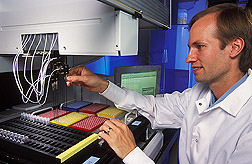Washington, DC, USA
May 3, 2010
Two Agricultural Research Service (ARS) scientists are part of an international team that has found a way to boost the nutritional value of corn. This has the potential to reduce the number of children in developing countries who lose their eyesight, become ill or die each year because of vitamin A deficiencies.
Corn contains carotenoids, some of which the body can convert to vitamin A. Beta-carotene is the best vitamin A precursor, but only a very small percentage of corn varieties have naturally high beta-carotene levels. In Africa and other developing regions, corn is a major staple and hundreds of thousands of children become blind, develop weakened immune systems and die because of diets based largely on corn that lacks sufficient beta-carotene.
 Marilyn Warburton, a geneticist with the ARS Corn Host Plant Resistance Research Unit in Starkville, Miss.; Edward Buckler (Photo), a geneticist in the ARS Robert W. Holley Center for Agriculture and Health in Ithaca, N.Y., and their colleagues published results identifying genetic sequences linked to higher beta-carotene levels in corn and demonstrating an inexpensive and fast way to identify corn plants that will produce even higher levels. The report, recently published in Nature Genetics, is considered a breakthrough in nutritional plant breeding.
Marilyn Warburton, a geneticist with the ARS Corn Host Plant Resistance Research Unit in Starkville, Miss.; Edward Buckler (Photo), a geneticist in the ARS Robert W. Holley Center for Agriculture and Health in Ithaca, N.Y., and their colleagues published results identifying genetic sequences linked to higher beta-carotene levels in corn and demonstrating an inexpensive and fast way to identify corn plants that will produce even higher levels. The report, recently published in Nature Genetics, is considered a breakthrough in nutritional plant breeding.
The project was funded in part by the National Science Foundation and included major scientific contributions from Torbert Rocheford of Purdue University and Jianbing Yan of the International Maize and Wheat Improvement Center in Mexico.
In their study, the researchers surveyed the genetic sequences of corn from around the world through association mapping, a method made possible by recent breakthroughs that accelerate the genetic profiling of crops.
The genetic survey revealed natural variations in one gene sequence linked to higher beta-carotene levels. These variations interacted with a gene identified previously, and the best variations of the two genes together led to an 18-fold increase in beta-carotene, according to Warburton. The mapping survey identified molecular markers that breeders can use to incorporate the desired gene variants into corn for the developing world. Warburton and Yan are now working with breeders oversees to train them on use of the new techniques.
Read more about this research in the May/June 2010 issue of Agricultural Research magazine.
ARS is the principal intramural scientific research agency of the U.S. Department of Agriculture (USDA). This research supports the USDA priority of promoting international food security.
Photo by Peggy Greb.
Un nuevo enfoque que preserva la vista y la vida en los países en vía de desarrollo
Dos científicos del Servicio de Investigación Agrícola (ARS) son miembros de un grupo internacional que ha descubierto una manera de aumentar el valor nutricional del maíz. Este avance tiene el potencial de reducir el número de niños en países en vía de desarrollo que pierden la vista, se ponen enfermos o mueren cada año como resultado de una deficiencia de vitamina D.
El maíz contiene los carotenoides, algunos de los cuales se convierten en vitamina A por el cuerpo humano. La beta carotina es la mejor precursora de la vitamina A, pero solamente un porcentaje muy pequeño de las variedades de maíz ahora disponibles naturalmente tienen niveles altos de beta carotina. En África y otras regiones en vía de desarrollo, el maíz es un componente esencial de la dieta, y cientos de miles de niños pierden la vista, desarrollan un sistema inmunitario debilitado, y mueren debido a sus dietas basadas principalmente en maíz que carecen de niveles suficientes de la beta carotina.
Marilyn Warburton, quien es genetista en la Unidad de Investigación de Plantas Huéspedes de Maíz mantenida por el ARS en Starkville, Misisipí; Edward Buckler, quien es genetista en el Centro Robert W. Holley de Agricultura y Salud mantenido por el ARS en Ithaca, Nueva York; y sus colegas publicaron resultados identificando secuencias genéticas relacionadas con niveles más altos de beta carotina en maíz, y también demostrando una manera económica y rápida de identificar las plantas de maíz que tienen la capacidad de producir niveles aún más altos. Este informe, publicado recientemente en la revista Naturaleza-Genética, se considera un avance importante en la crianza de plantas más nutricionales.
El proyecto fue patrocinado por la Fundación Nacional de Ciencia y incluyó contribuciones científicas importantes por Torbert Rocheford de la Universidad de Purdue y Jianbing Yan del Centro Internacional de Mejoramiento de Maíz y Trigo en Mexico.
En su estudio, los investigadores estudiaron las secuencias genéticas de muestras de maíz de todas partes del mundo utilizando el nuevo método de “mapear de asociaciones”.
El estudio reveló variaciones naturales en una secuencia genética relacionada con niveles más altos de la beta carotina. Estas variaciones reaccionan con un gen previamente identificado, y las mejores variaciones de los dos genes juntos llevaron a un aumento de 18 veces en el nivel de beta carotina, según Warburton. La evaluación identificó marcadores moleculares que los criadores de plantas pueden usar para incorporar las variantes genéticas deseadas en variedades de maíz para los países en vía de desarrollo. Warburton y Yan ahora están trabajando con criadores en otros países para enseñarlos en la utilización de las nuevas técnicas.
Lea más sobre esta investigación en la revista 'Agricultural Research' de mayo-junio del 2010.
ARS es la agencia principal de investigaciones científicas del Departamento de Agricultura de EE.UU. (USDA por sus siglas en inglés). Esta investigación apoya la prioridad del USDA de promover la seguridad alimentaria internacional.